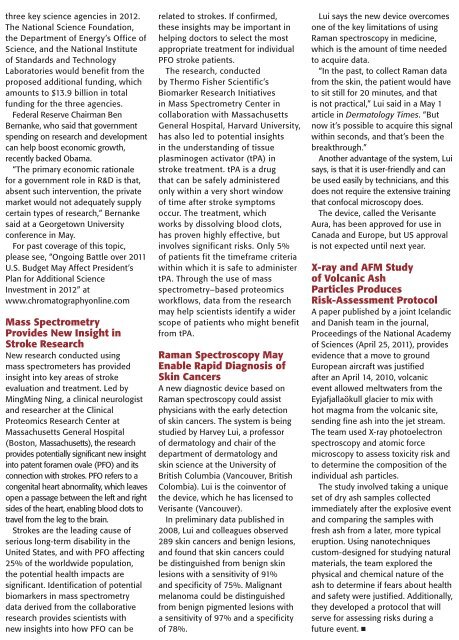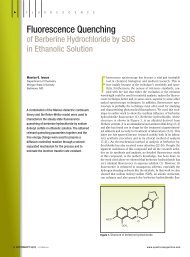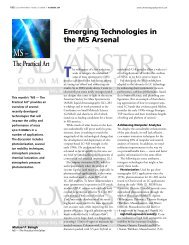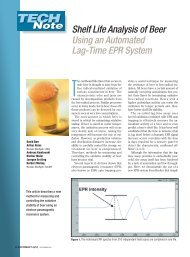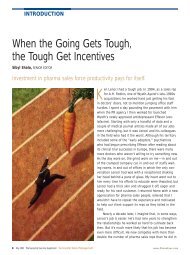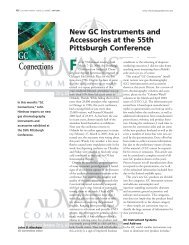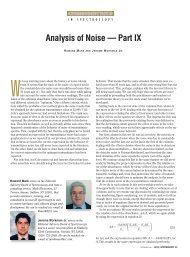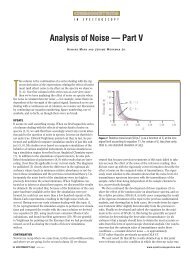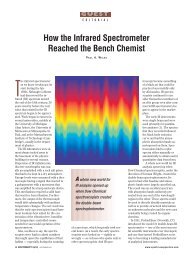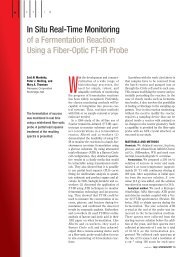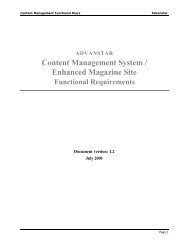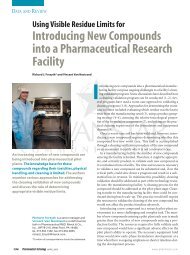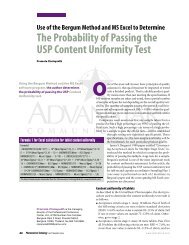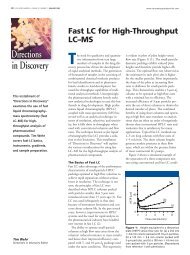Experimental - Spectroscopy
Experimental - Spectroscopy
Experimental - Spectroscopy
Create successful ePaper yourself
Turn your PDF publications into a flip-book with our unique Google optimized e-Paper software.
12 <strong>Spectroscopy</strong> 26(6) June 2011 www.spectroscopyonline.com<br />
three key science agencies in 2012.<br />
The National Science Foundation,<br />
the Department of Energy’s Office of<br />
Science, and the National Institute<br />
of Standards and Technology<br />
Laboratories would benefit from the<br />
proposed additional funding, which<br />
amounts to $13.9 billion in total<br />
funding for the three agencies.<br />
Federal Reserve Chairman Ben<br />
Bernanke, who said that government<br />
spending on research and development<br />
can help boost economic growth,<br />
recently backed Obama.<br />
“The primary economic rationale<br />
for a government role in R&D is that,<br />
absent such intervention, the private<br />
market would not adequately supply<br />
certain types of research,” Bernanke<br />
said at a Georgetown University<br />
conference in May.<br />
For past coverage of this topic,<br />
please see, “Ongoing Battle over 2011<br />
U.S. Budget May Affect President’s<br />
Plan for Additional Science<br />
Investment in 2012” at<br />
www.chromatographyonline.com<br />
Mass Spectrometry<br />
Provides New Insight in<br />
Stroke Research<br />
New research conducted using<br />
mass spectrometers has provided<br />
insight into key areas of stroke<br />
evaluation and treatment. Led by<br />
MingMing Ning, a clinical neurologist<br />
and researcher at the Clinical<br />
Proteomics Research Center at<br />
Massachusetts General Hospital<br />
(Boston, Massachusetts), the research<br />
provides potentially significant new insight<br />
into patent foramen ovale (PFO) and its<br />
connection with strokes. PFO refers to a<br />
congenital heart abnormality, which leaves<br />
open a passage between the left and right<br />
sides of the heart, enabling blood clots to<br />
travel from the leg to the brain.<br />
Strokes are the leading cause of<br />
serious long-term disability in the<br />
United States, and with PFO affecting<br />
25% of the worldwide population,<br />
the potential health impacts are<br />
significant. Identification of potential<br />
biomarkers in mass spectrometry<br />
data derived from the collaborative<br />
research provides scientists with<br />
new insights into how PFO can be<br />
related to strokes. If confirmed,<br />
these insights may be important in<br />
helping doctors to select the most<br />
appropriate treatment for individual<br />
PFO stroke patients.<br />
The research, conducted<br />
by Thermo Fisher Scientific’s<br />
Biomarker Research Initiatives<br />
in Mass Spectrometry Center in<br />
collaboration with Massachusetts<br />
General Hospital, Harvard University,<br />
has also led to potential insights<br />
in the understanding of tissue<br />
plasminogen activator (tPA) in<br />
stroke treatment. tPA is a drug<br />
that can be safely administered<br />
only within a very short window<br />
of time after stroke symptoms<br />
occur. The treatment, which<br />
works by dissolving blood clots,<br />
has proven highly effective, but<br />
involves significant risks. Only 5%<br />
of patients fit the timeframe criteria<br />
within which it is safe to administer<br />
tPA. Through the use of mass<br />
spectrometry–based proteomics<br />
workflows, data from the research<br />
may help scientists identify a wider<br />
scope of patients who might benefit<br />
from tPA.<br />
Raman <strong>Spectroscopy</strong> May<br />
Enable Rapid Diagnosis of<br />
Skin Cancers<br />
A new diagnostic device based on<br />
Raman spectroscopy could assist<br />
physicians with the early detection<br />
of skin cancers. The system is being<br />
studied by Harvey Lui, a professor<br />
of dermatology and chair of the<br />
department of dermatology and<br />
skin science at the University of<br />
British Columbia (Vancouver, British<br />
Colombia). Lui is the coinventor of<br />
the device, which he has licensed to<br />
Verisante (Vancouver).<br />
In preliminary data published in<br />
2008, Lui and colleagues observed<br />
289 skin cancers and benign lesions,<br />
and found that skin cancers could<br />
be distinguished from benign skin<br />
lesions with a sensitivity of 91%<br />
and specificity of 75%. Malignant<br />
melanoma could be distinguished<br />
from benign pigmented lesions with<br />
a sensitivity of 97% and a specificity<br />
of 78%.<br />
Lui says the new device overcomes<br />
one of the key limitations of using<br />
Raman spectroscopy in medicine,<br />
which is the amount of time needed<br />
to acquire data.<br />
“In the past, to collect Raman data<br />
from the skin, the patient would have<br />
to sit still for 20 minutes, and that<br />
is not practical,” Lui said in a May 1<br />
article in Dermatology Times. “But<br />
now it’s possible to acquire this signal<br />
within seconds, and that’s been the<br />
breakthrough.”<br />
Another advantage of the system, Lui<br />
says, is that it is user-friendly and can<br />
be used easily by technicians, and this<br />
does not require the extensive training<br />
that confocal microscopy does.<br />
The device, called the Verisante<br />
Aura, has been approved for use in<br />
Canada and Europe, but US approval<br />
is not expected until next year.<br />
X-ray and AFM Study<br />
of Volcanic Ash<br />
Particles Produces<br />
Risk-Assessment Protocol<br />
A paper published by a joint Icelandic<br />
and Danish team in the journal,<br />
Proceedings of the National Academy<br />
of Sciences (April 25, 2011), provides<br />
evidence that a move to ground<br />
European aircraft was justified<br />
after an April 14, 2010, volcanic<br />
event allowed meltwaters from the<br />
Eyjafjallaökull glacier to mix with<br />
hot magma from the volcanic site,<br />
sending fine ash into the jet stream.<br />
The team used X-ray photoelectron<br />
spectroscopy and atomic force<br />
microscopy to assess toxicity risk and<br />
to determine the composition of the<br />
individual ash particles.<br />
The study involved taking a unique<br />
set of dry ash samples collected<br />
immediately after the explosive event<br />
and comparing the samples with<br />
fresh ash from a later, more typical<br />
eruption. Using nanotechniques<br />
custom-designed for studying natural<br />
materials, the team explored the<br />
physical and chemical nature of the<br />
ash to determine if fears about health<br />
and safety were justified. Additionally,<br />
they developed a protocol that will<br />
serve for assessing risks during a<br />
future event. ◾


